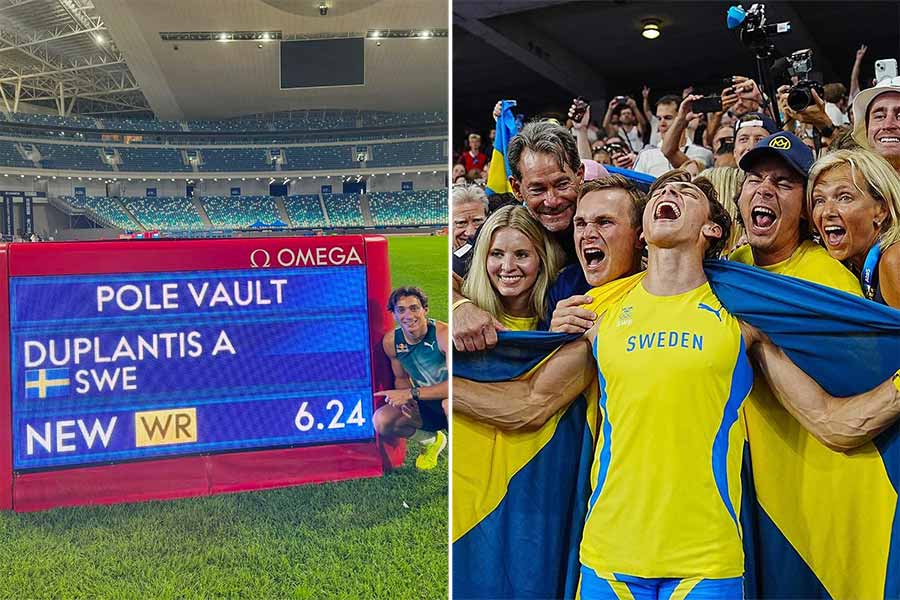Have you ever observed a goldsmith or a coppersmith? Someone working with manual tools and metal? They are able to transform a plain sheet of metal into an unbelievably complex object. How? By repeatedly striking evenly-weighted, strategic blows on the sheet. Perfectly measured every single time. Too little force and the metal won’t bend. Too much force and the metal will thin out. It takes hours. I saw a video of a gold sheet being made into a kettle. Even on timelapse, it took 12 minutes. When a footballer perfectly threads a pass through the back line, it is the same principle at play. Too much force on the ball and it goes beyond the winger. Too little and the defender intercepts it.
Let’s go back to the Paris Olympic Games. It’s 10.15 at night, local time. The track events have long finished, but nobody is moving an inch. Armand Duplantis, wearing the Swedish yellow, shows up for his date with history. The event begins with Duplantis clearing 6m. Other competitors try but fail to match him. Sam Kendricks (USA) settles for silver and Emmanouil Karalis (Greece) bronze. The normal reaction would be to celebrate the gold. Duplantis does so. Brief hugs with family and then gets to work.
He first breaks the Olympic record (6.03m). Then he glides over 6.10m with a lot of space to spare. If you watch the highlights, you will see a near metronomic precision to his running, and a perfect and steady angle of the pole. Repeatable and repeated. Eventually, he moves up to the world record at 6.25m. For context, that is the height of a large giraffe. He fails in his first two attempts, but then takes a break, stretching out his back. Then he runs in once again — everything perfectly in sync, exactly like he had been running in earlier. His hair trailing in the wind, Duplantis launches himself in the air in one smooth motion. This time he celebrates, letting off a primordial roar, even before gravity pulls him down onto the mat. When he gets up, Duplantis is as excited as those in the stands, all agog at witnessing history, but boring is what got him there.
How many times do you think Duplantis had repeated what he did at Paris that night? Going by the conservative estimate of two pole vault sessions a week with 30 vaults each multiplied by 10 years, he had done it at least 31,200 times.
The platform for skill acquisition
All of us go through three fundamental phases when we try to become an ‘expert’ at anything. The first is the Understanding phase, where we try to gain a basic understanding of what the skill involves. We need coaches, teachers and demonstrations to help us with this part, whatever the skill, dribbling a basketball or slicing an onion. We require a lot of brainpower for this phase and are generally quite uncoordinated to start with. Only if we ‘pass’ this stage do we go to the Association phase, where we repeat and refine the technique we have learnt, so that we can become more consistent. We still make a few errors, but we are better than before — we can dribble a few times and we can cut an onion in 2-3 minutes (without chopping any fingers off). Most skills that we have stay at this level for a long period of time. Getting from this level to the next is usually something that takes a lot of time and effort. People usually disengage before that can happen.

After the guidance of coaches in the Understanding phase, one reaches the Association phase of refining techniques like being able to cut an onion in 2-3 minutes, without chopping any fingers off
The last step is the ‘Autonomous-Expertise phase, where one can fluidly perform a skill without much conscious thought. Most people never reach this stage in more than three skills. Duplantis has clearly reached this stage with this pole vaulting.
The secret of going through these stages is actually boring repetition. What matters is whether you can do the same thing again and again in the exact same way. Repetitions are crucial to skill acquisition because they help consolidate muscle memory and refine technique. Every time you repeat something, your brain strengthens the neural pathways for that skill, making it 0.00000001% easier each time. Repetition also allows you to fine tune how to do something and adapt it. In the modern world, where every product must be new and there is an endless succession of reels, each less than 30 seconds, we can end up overlooking the value of repetition. A physiotherapist I know recently told me: “Most people now have better coordination on their right thumb, thanks to all the scrolling, than they have in any other body part.” And this goes for any skill. Duplantis had to do it a minimum of 31,200 times. Which skill have you repeated boringly 31,200 times in your life?
Dr Sahen Gupta is a Kolkata-born, India- and UK-based psychologist who divides his time between mental health support and high-performance coaching. As the founder of Discovery Sport & Performance Lab, he works not only with Olympians and other top-level sportspersons, but also with CEOs and other professionals striving for excellence. Dr Gupta’s mission is to simplify complexities of the mind into actionable and simple ‘doables’ that allow individuals to be mentally fit.


